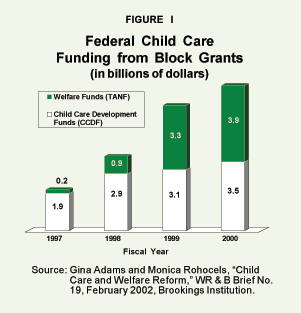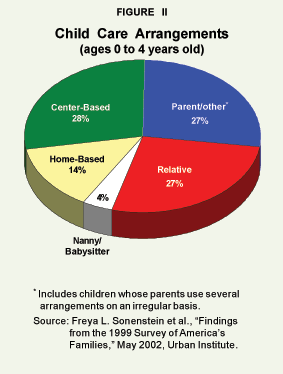Access to safe and affordable child care has been a major issue in the congressional debate on reauthorization of the 1996 welfare reform law. The Bush administration has proposed — and the U.S. House of Representatives has passed — a bill that would authorize spending $22 billion per year on child care, cash assistance and work-support programs for the needy. Some Senate Democrats contend the proposed funding is not enough to provide child care assistance to parents who need it, and they are demanding an additional $5.5 billion to $7 billion over the next five years.
Concern about the adequacy of child care funding was prompted by a 1999 U.S. Department of Health and Human Services finding that only 12 percent of eligible children were receiving federal child care assistance. Furthermore, waiting lists of parents seeking child care subsidies have developed in a number of states, indicating that the demand is greater than the funds available.
Is funding inadequate — or simply, in some states, misdirected?
Child Care and Welfare Reform.
The 1996 law establishing Temporary Assistance to Needy Families (TANF) replaced the federal entitlement to welfare with a program that requires recipients to work and time-limits their receipt of cash assistance. The federal government and the states fund TANF, and individual states have great flexibility in designing and administering the program.
Welfare rolls have fallen more than 50 percent under TANF, to approximately 2 million families in June 2002. However, the amount of federal funds each state receives has remained level. This has enabled states to fund work-support programs, including child care for current and former welfare recipients who work.
Federal Child Care Funding.
Federal child care funds come from TANF and the Child Care Development Fund (CCDF), created in the 1996 welfare reform legislation by combining four existing programs. States have flexibility in spending these block grants. They may use TANF directly for child care assistance or transfer up to 30 percent of their TANF block grant to CCDF.
Child care funding has more than tripled since 1996. As welfare rolls fell, the proportion of welfare funds spent on cash payments fell from 70 percent of TANF spending in 1995 to 50 percent in 2000. This freed TANF funds for child care assistance. Thus the largest source of funds in recent years has been the TANF block grants.
- In 1997, CCDF provided $1.9 billion for child care aid, while states spent only $200 million of their TANF funds on child care.
- By 2000, CCDF had increased to $3.5 billion, and TANF child care funding had increased to $3.9 billion. [See Figure I.]
- The number of children receiving child care assistance rose from 2 million in 1996 to 3.6 million in 2002, according to HHS.
Working parents are also eligible for a refundable federal child tax credit of up to $600 per child, which President Bush has proposed increasing to $1,000. The tax credit is phased out at higher income levels, which are set by federal law, but the phaseout does not begin until family income reaches $75,000 for a single parent or $110,000 for a married couple filing jointly.
Who Needs Child Care?
If child care assistance is available, why have so few parents applied? One reason is that many eligible parents choose care by a family member or other individual caregiver rather than formal care. Aid is usually not available for informal child care.
- According to the Urban Institute’s 1999 National Survey of America’s Families, 54 percent of preschool children with an employed parent were cared for by the other parent, another relative or an unrelated individual either in the caregiver’s or the child’s home. [See Figure II.]
- For school children ages 6 to 12, the number rose to 64 percent.
Most child care is paid for by parents, and the cost of licensed, formal day care is one reason parents choose family care. The average American family pays between $4,000 and $6,000 per year for child care, or approximately $77 to $115 a week. However, cost is not a barrier for most welfare recipients. The average cost to parents of subsidized child care was $11 a week in 2000, according to calculations by the Heritage Foundation based on Children’s Defense Fund data.
What Do Waiting Lists Mean?
Parents usually receive child care subsidies in the form of vouchers for use at any licensed center. The amount of aid they receive is usually based on a sliding income scale set by each state. Average state eligibility limits include working families with incomes up to 196 percent of the federal poverty level. In 2001 the upper income limit to receive aid ranged from $18,048 in Alabama to $47,586 in Connecticut.
In states with high upper income limits, the pool of eligible families tends to be large. These states have waiting lists for assistance, and they are cited by legislators who favor increasing federal aid. However, most of the wait-listed parents are not current or former welfare recipients.
- In 2000, a study by Abt Associates for the U.S. Department of Health and Human Services found that the states were able to provide aid to all families currently receiving TANF benefits.
- Furthermore, states were able to provide child care aid to all eligible families leaving TANF in 1999 for at least the following year.
Wait-listing problems occur, for the most part, with low-income families who are not now receiving or have not recently received welfare and who are, in most states, given a lower priority than welfare recipients or recent welfare leavers.
Yet a study conducted by the Children’s Defense Fund found that, in 2001, 29 states were able to provide aid to all eligible applicants, rather than creating waiting lists or refusing new applicants. The income qualification in the remaining states is as high as Connecticut’s $47,586 for a family of three, so many on waiting lists are above the poverty line. If these states targeted funds to families in poverty, they would have been able to assist all applicants who need help.
Conclusion.
The president has proposed increasing work requirements for welfare recipients, and as these people go to work, child care assistance is important. But with fewer people receiving cash assistance, states already have been able to shift more money to child care. By redirecting the money to the neediest families, states can provide ample child care assistance with the current funding levels.
Jennifer Trice is an intern with the National Center for Policy Analysis.